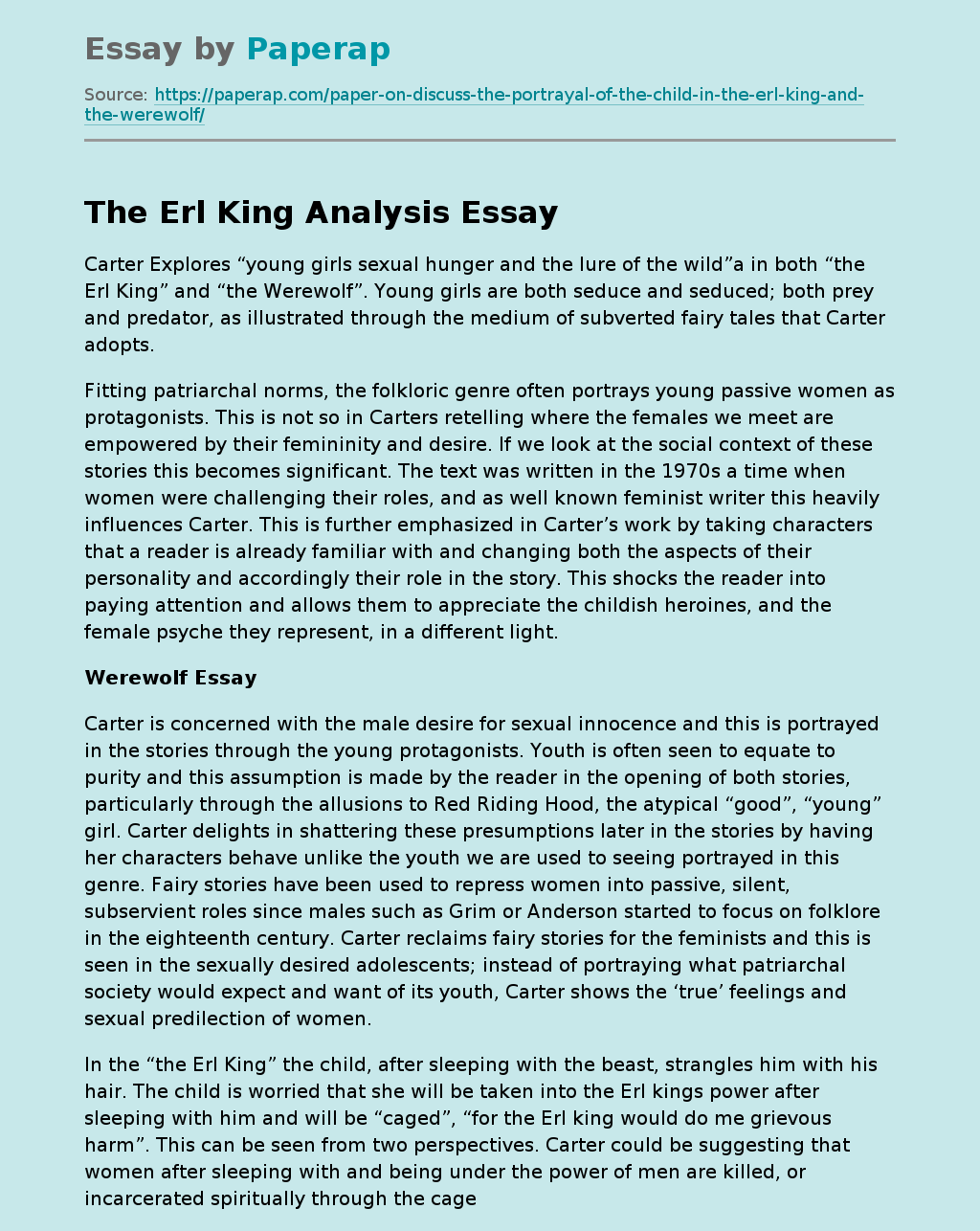The Erl King Analysis
Carter Explores “young girls sexual hunger and the lure of the wild”a in both “the Erl King” and “the Werewolf”. Young girls are both seduce and seduced; both prey and predator, as illustrated through the medium of subverted fairy tales that Carter adopts.
Fitting patriarchal norms, the folkloric genre often portrays young passive women as protagonists. This is not so in Carters retelling where the females we meet are empowered by their femininity and desire. If we look at the social context of these stories this becomes significant.
The text was written in the 1970s a time when women were challenging their roles, and as well known feminist writer this heavily influences Carter. This is further emphasized in Carter’s work by taking characters that a reader is already familiar with and changing both the aspects of their personality and accordingly their role in the story. This shocks the reader into paying attention and allows them to appreciate the childish heroines, and the female psyche they represent, in a different light.
Werewolf Essay
Carter is concerned with the male desire for sexual innocence and this is portrayed in the stories through the young protagonists. Youth is often seen to equate to purity and this assumption is made by the reader in the opening of both stories, particularly through the allusions to Red Riding Hood, the atypical “good”, “young” girl. Carter delights in shattering these presumptions later in the stories by having her characters behave unlike the youth we are used to seeing portrayed in this genre.
Fairy stories have been used to repress women into passive, silent, subservient roles since males such as Grim or Anderson started to focus on folklore in the eighteenth century. Carter reclaims fairy stories for the feminists and this is seen in the sexually desired adolescents; instead of portraying what patriarchal society would expect and want of its youth, Carter shows the ‘true’ feelings and sexual predilection of women.
In the “the Erl King” the child, after sleeping with the beast, strangles him with his hair. The child is worried that she will be taken into the Erl kings power after sleeping with him and will be “caged”, “for the Erl king would do me grievous harm”. This can be seen from two perspectives. Carter could be suggesting that women after sleeping with and being under the power of men are killed, or incarcerated spiritually through the caged bird metaphor seen here. However, on a more symbolic level the Erl King could in fact be allegorical of the repression of sexual desire; the child in the story both “loves” him but fears for the consequence of her affections, and desires “mock my loss of liberty”. The act of strangling him with his hair, often seen to denote purity and innocence, is in fact symbolic of men’s oppression of female sexual desire; their need for purity has caused women to “lose their flesh … in the corrosive pool of his regard”.
In a similar manner, the young girls actions in “the Werewolf” also be demonstrate female repression. A Jungian reading of the text is very revealing. Carl Jung said that “animus represents the masculine aspects of the psyche in women, and the anima the female psyche in males”bi. In “the Werewolf”, the young girl has both the animas and the female psyche and if a Jungian view is upheld then the story is really concerned with the girl’s battle between which of these forces is to be more dominant. The traditional phallic symbol of the knife relates to the animas and the basket of food has connotations with female genitalia. The girl on the sight of the wolf, “drops her basket and seizes her knife”, her animus becomes dominant in order to deal with the dangers of real life. The girl later “prospers”, and it is suggested that this is through the loss of femininity of the youth. Carter suggests that in order to succeed in this world you must make you self-effeminate because masculinity is dominant. The symbolic meaning behind the werewolf in the unconscious seems important in this story where a girl is both attacked and attacks one of these creatures:
“To dream that you are a werewolf, suggests that some aspects of your personality are hurtful and even dangerous to your own well-being. You are headed down an undesirable path. Alternatively, it refers to your repressed instincts.” c
Through this means Carter suggests that women’s repression of their femininity goes against their self and cause them to go down an undesirable path in their psychological forest.
In Carters work she portrays the child very differently to what we expect of a fairytale character, as her tales are not designed to be read to the young, but rather to fit their original purpose of teaching female adolescents of their sexual desires and the pitfalls of the world around them. She focuses on the psychological aspect of her stories keeping them in keeping with a genre traditionally full of the subliminal. It has been suggested that Carters work could viewed by Freud’s personal unconsciousness theory, where we are forced to dream in order to deal with the issues around us that are socially repressed in the world we live in. Carter portrays her young children, as the fixings of a woman’s mind where by their exploits are in fact a coping mechanism in a world where youth, innocence and the animus are preferred.
The Erl King Analysis. (2019, Dec 05). Retrieved from https://paperap.com/paper-on-discuss-the-portrayal-of-the-child-in-the-erl-king-and-the-werewolf/

